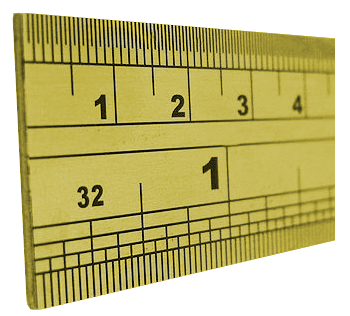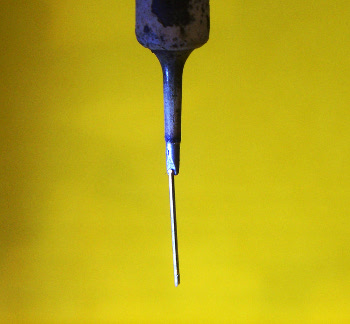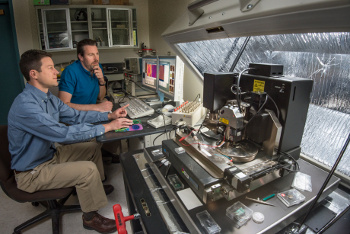A Thermal Switch
June 1, 2015
As knowledgeable
homeowners realize when paying their
winter heating bills,
thermal conductivity is an important
material property.
Home insulation is identified by a
quality measure called the
R-value. Since people like to relate better things with higher numbers, the R-value is used instead of its
reciprocal, called the
thermal transmittance (U-value). The U-value is the rate of
heat transfer in a
square meter area divided by the
temperature difference across the
insulator, so it has units of
W/
m2-
K.
The R-value is the reciprocal of this, so it has units m
2-K/W. Since the US still
clings to older measurement units, R-values are expressed here as
°F-
ft2/(
Btu/hr). I was part of my former employer's
metrication team in the early
1980s, so there's been a lot of talk, but no progress, in US metrication in three
decades. There are times, however, when customary units are better; e.g.,
weather reports in
Fahrenheit express more
accuracy than those in
Celsius.

According to folklore, the customary length unit, the yard was defined as the distance from nose to fingertips of the outstretched arm of King Henry I of England (1068-1135).
(Modified Wikimedia Commons image.)
Typical
fiberglass batting for home insulation is sold as R-30. Thirty is what you get when you
multiply the R-value of fiberglass batts (about 4) by the thickness in
inches. Highly
energy-efficient homes will even have exterior
walls of greater thickness than the traditional 3-1/2 inch width of a
wooden stud in order to accommodate more insulation. Of course, much of the heat from buildings is lost through
windows, so
multiple glass panes are important.
There's a story (
Wikipedia "
citation needed"
folklore, but probably true) that the
Tasmanian house of
radio astronomy pioneer,
Grote Reber (1911-2002), was so well insulated that he wasn't able to use his
cooking oven, since it would overheat the house. Here's a table of R-values for common
building materials.
Material | R-value
(°F-ft2/(Btu/hr) |
| Poured concrete | 0.08 |
| Glass | 0.14 |
| Hardwood (typical) | 0.71 |
| Snow | 1 |
| Brick | 1.5 |
| Vermiculite (loose-fill) | 2.25 |
| Plywood | 2.55 |
| Cellulose (loose-fill) | 3.5 |
| Cotton batts | 3.7 |
| Home foam | 3.9 |
| Fiberglass batts | 4 |
| Vacuum panel | 40 |
I've written many articles about thermal conductivity on this blog, one of which,
Thermal Diodes, February 19, 2014, was about devices designed to conduct heat in just one direction. One
thermal diode has been proven by
experiment,[1-2] while another has been shown to be feasible in
theory.[3-4] The trick to making such a device is manipulation of
phonons, the quantized acoustic vibrations in solids principally responsible for
heat conduction in solids.
A
thermal switch is just as valuable as a thermal diode. An
automatic mechanical thermal switch was patented by
Carl E. Weller in 1960 as a mean of maintaining the temperature of a
soldering iron.[5] Some applications would benefit from an
electrically-
actuated,
solid state thermal switch with no moving parts.
Scientists at
Sandia National Laboratories (Albuquerque, New Mexico), the
University of Virginia (Charlottesville, Virginia), and
Pennsylvania State University (University Park, Pennsylvania) have recently reported a thermal switch based on the common material,
lead zirconate titanate (Pb(Zr
0.3Ti
0.7)O
3.[6-7]

Carl Weller patented a mechanical thermal switch for keeping a soldering iron tip at the proper temperature. The design has a spring-loaded magnet (shown here attracting a nickel-coated wire). The magnetism vanishes at the Curie temperature, throwing the thermal switch.[5]
(Photo by the author)
A solid-state thermal switch would enable such exotic
technologies as
phononic logic, as well as offering improvements in
thermal management and
energy harvesting.[6] PZT is a common material that's used in
ceramic and
thin film form for
actuators,
speakers, and
spark generators for lighting
barbecue grills.[7]
The thermal switch operates by controlling the
nanoscale ferroelectric domain walls in the material, and this leads to control of the heat transmitting phonons. The demonstration device has a
subsecond response time, and the
room temperature thermal conductivity could be changed by 11%.[6-7]
It takes just the
voltage from a
nine-volt battery to effect the 11% thermal conductivity change at room temperature.[7] Says Jon Ihlefeld of Sandia National Laboratories,
"We can alter PZT's thermal conductivity over a broad temperature range, rather than only at the cryogenic temperatures achieved by other research groups... and we can do it reversibly: When we release our voltage, the thermal conductivity returns to its original value... We feel this groundbreaking work will advance the field of phononics."[7]
The research team investigated the mechanism for the thermal switching action through use of an
atomic force microscope and a
scanning electron microscope. A change in the shape and length of the the ferroelectric domain walls is what alters the phonon transport in the PZT material, and this affects the thermal conductivity.[7]

Thermal experiments require care.
Note the insulated cabinet for this Sandia atomic-force microscope.
(Sandia photo by Randy Montoya.[7]
This research was supported by Sandia's
Laboratory Directed Research and Development office, the
Air Force Office of Scientific Research, and the
National Science Foundation.[7]
References:
- W. Kobayashi, Y. Teraoka and I. Terasaki, "An oxide thermal rectifier," Applied Physics Letters, vol. 95, no. 17 (October, 2009), Document No. 171905 (3 pages).; available, also, on arXiv.
- Heat Diode Paves the Way For Thermal Computing, Technology Review, October 9, 2009.
- Yan Wang, Ajit Vallabhaneni, Jiuning Hu, Bo Qiu, Yong P. Chen and Xiulin Ruan, "Phonon Lateral Confinement Enables Thermal Rectification in Asymmetric Single-Material Nanostructures," Nano Letters, Article ASAP (January 6, 2014), DOI: 10.1021/nl403773f.
- Emil Venere, "Research could bring new devices that control heat flow," Purdue University Press Release, January 27, 2014.
- Carl E. Weller, "Electric Soldering Iron," US Patent No. 2,951,927, September 6, 1960.
- Jon F. Ihlefeld, Brian M. Foley, David A. Scrymgeour, Joseph R. Michael, Bonnie B. McKenzie, Douglas L. Medlin, Margeaux Wallace, Susan Trolier-McKinstry, and Patrick E. Hopkins, "Room-Temperature Voltage Tunable Phonon Thermal Conductivity via Reconfigurable Interfaces in Ferroelectric Thin Films," Nano Lett., vol. 15, no. 3 (March 11, 2015), pp. 1791-1795, DOI: 10.1021/nl504505t.
- Jon Ihlefeld, "Phonons, arise! - Small electric voltage alters conductivity in key materials," Sandia Labs Press Release, April 22, 2015.
Permanent Link to this article
Linked Keywords: Owner-occupier; homeowner; winter; HVAC; heating; invoice; bill; thermal conductivity; material property; building insulation; home insulation; quality measure; R-value; multiplicative inverse; reciprocal; thermal transmittance; heat transfer; square meter; area; temperature; thermal insulation; insulator; watt; kelvin; United States customary units; Fahrenheit; square foot; British thermal unit; Btu; metrication; 1980s; decade; weather forecasting; weather report; Fahrenheit; accuracy; Celsius; folk etymology; folklore; yard; nose; fingertip; King Henry I of England (1068-1135); Wikimedia Commons; building insulation material; fiberglass batting; multiplication; multiply; inch; energy conversion efficiency; energy-efficient; home; wall; wall stud; wooden stud; window; multiple glass panes; citation needed; Tasmania; Tasmanian; radio astronomy; innovator; pioneer; Grote Reber (1911-2002); cooking oven; building materials; thermal diode; experiment; theory; phonon; quantization; quantized; acoustics; acoustic vibration; solid; thermal conduction; heat conduction; temperature; thermal; switch; automatic; mechanical; Carl E. Weller; soldering iron; electricity; electrical; actuator; actuate; scientist; Sandia National Laboratories (Albuquerque, New Mexico); University of Virginia (Charlottesville, Virginia); Pennsylvania State University (University Park, Pennsylvania); lead zirconate titanate; soldering iron; spring; magnet; nickel; wire; magnetism; Curie temperature; technology; phonon; phononic; logic gate; logic; thermal management; energy harvesting; ceramic; thin film; actuator; loudspeaker; speaker; electric spark; barbecue grill; nanoscopic scale; nanoscale; ferroelectricity; ferroelectric; domain wall; second; response time; room temperature; voltage; nine-volt battery; cryogenic; research; reversible process; phononics; atomic force microscope; scanning electron microscope; Randy Montoya; Laboratory Directed Research and Development office; Air Force Office of Scientific Research; National Science Foundation; Carl E. Weller, "Electric Soldering Iron," US Patent No. 2,951,927, September 6, 1960.